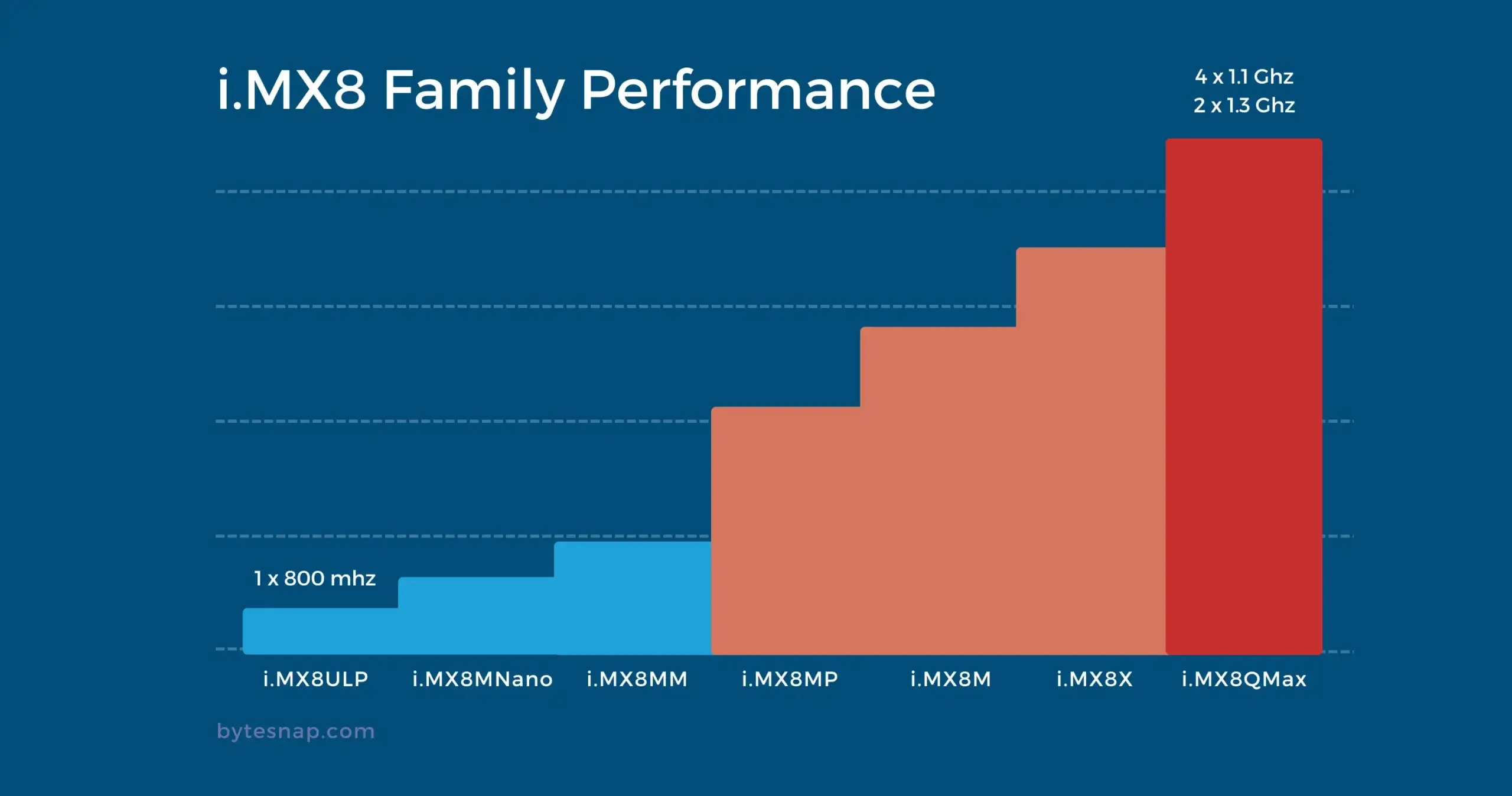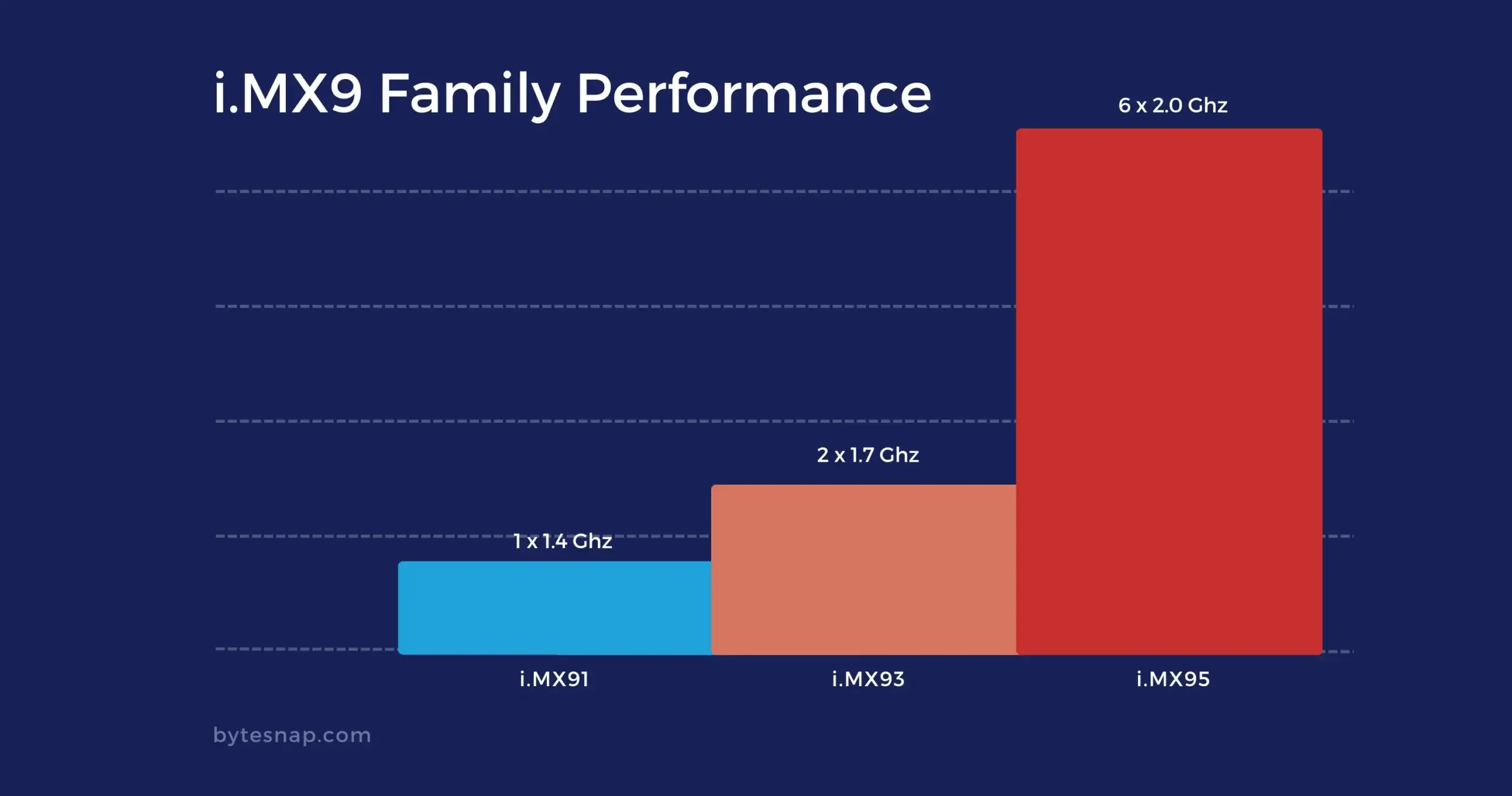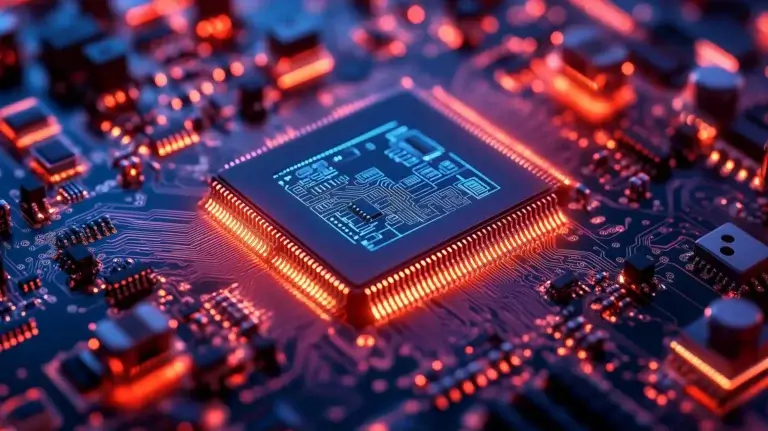Comparing NXP's i.MX8 vs i.MX9: A Comprehensive Guide
NXP i.MX8 and i.MX9x are two of the current ranges of embedded application processors that are the go-to building blocks for many industrial, medical, automotive, security or other specialised industry devices commonly known as “embedded devices” built on SoM or single board computing systems.
NXP i.MX CPUs are known as SoC (System on Chip) devices, meaning that many of the core features you require in the product are available out of the CPU silicon and don’t require additional companion chips like many desktop or laptop CPUs would.
These devices are normally running Linux as the choice of operating system, giving them a fully featured and secure operating system to build a single purpose device from a smart watch to performance equipment – like large high-definition passenger information panels.
The device range caters for diverse needs, different core strengths from power efficiency, graphical processing, numerical compute power, AI compute engines, wired connectivity etc.
One thing that all the devices have in common are strong security features, time term longevity and strong operating system support. As mentioned, OS support is primarily Linux but with other operating systems such as QNX, Windows Enterprise ARM, Android, FreeRTOS and others also.
In this article, we will compare and contrast a number of NXP i.MX8 and i.MX9x CPUs, focusing on why you’d pick them either for their performance, features, power consumption, and availability for your next IoT product.
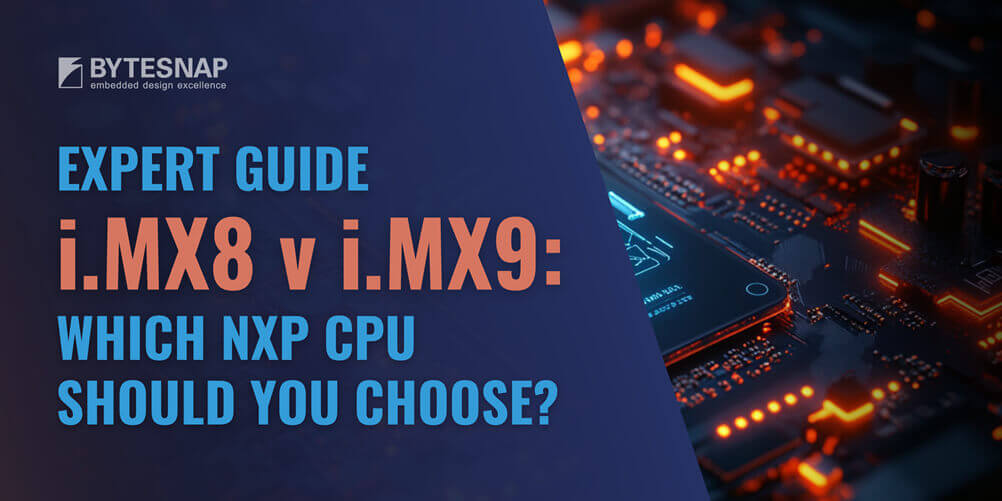
Section 1: i.MX8 vs i.MX9 Performance Analysis
The performance of a CPU is a crucial factor to consider when evaluating its suitability for a particular application. The NXP i.MX8 family offers several models with varying levels of performance.
The two contrasting devices here on different ends of the scale are:
- i.MX8ULP: This model has either 1 or 2 Arm Cortex-A35 cores running at 800Mhz There is a built-in super low power M33 microcontroller core that can operate at up to 216Mhz whilst the A cores are suspended. This is ideal for smart watches, e-ink devices and other small battery powered technology. Even with this ultra-low power device there is a 3D GPU and MIPI display support.
-
- i.MX8QuadMax: With two Arm Cortex-A72 cores @1.3Ghz, four Arm Cortex-A53 cores @1.1Ghz, and dual Cortex-M4F cores running @264Mhz. The i.MX8QuadMax is a beast designed for high-performance computing tasks. Not one but two GC7000 3D GPUs are included that can be linked for very high compute tasks or split between output panels.

So, you may be wondering why the introduction mentioned the i.MX9x series as well…
This is because whilst you have a great choice of options in the i.MX8 range, some key features are lacking, such as dual Ethernet and a high number of serial connectivity (RS485 / SPI / I2C etc) for interfacing with many sensor devices found on some industrial equipment.
The i.MX93 range features all A53 cores, ranging from 1 to 6 cores and from 1.4Ghz to 2.0Ghz, this gives another huge range that overlaps and extends the i.MX8 range again, especially on the high end of the scale.

- i.MX8QuadMax: With two Arm Cortex-A72 cores @1.3Ghz, four Arm Cortex-A53 cores @1.1Ghz, and dual Cortex-M4F cores running @264Mhz. The i.MX8QuadMax is a beast designed for high-performance computing tasks. Not one but two GC7000 3D GPUs are included that can be linked for very high compute tasks or split between output panels.
Putting together but keeping the two i.MX9x and i.MX8 separate, these are the CPU A and M core details:
i.MX91 | i.MX93 | i.MX95 | i.MX8ULP | i.MX8M Nano | |
|---|---|---|---|---|---|
A Cores | 1 x A55 @ 1.4 Ghz | 2 x A55 @ 1.7 Ghz | 6 x A55 @ 2.0 Ghz | 1-2 x A35 @ 800 Mhz | 4 x A53 @ 1.5 Ghz |
M Cores | No | 1 x m33 @ 250 Mhz | 1 x M7 @ 800 Mhz
1 x M3 @ 250 Mhz | 1 x M33 @ 216 Mhz | 1 x M7 @ 750 Mhz |
i.MX8MM | i.MX8MP | i.MX8M | i.MX8X | i.MXQMax | |
|---|---|---|---|---|---|
A Cores | 1-4 x A53 @ 1.8 Ghz | 4 x A53 @ 1.6 Ghz | 4 x A53 @ 1.5 Ghz | 2/4 x A35 @ 1.2 Ghz | 4 x A53 @ 1.1 Ghz2 x A72 @ 1.3 Ghz |
M Cores | 1 x M4 @ 400 Mhz | 1 x M7 @ 800 Mhz | 1 x M4 @ 266 Mhz | 1 x M4 @ 266 Mhz | 2 x M4 @ 264 Mhz |
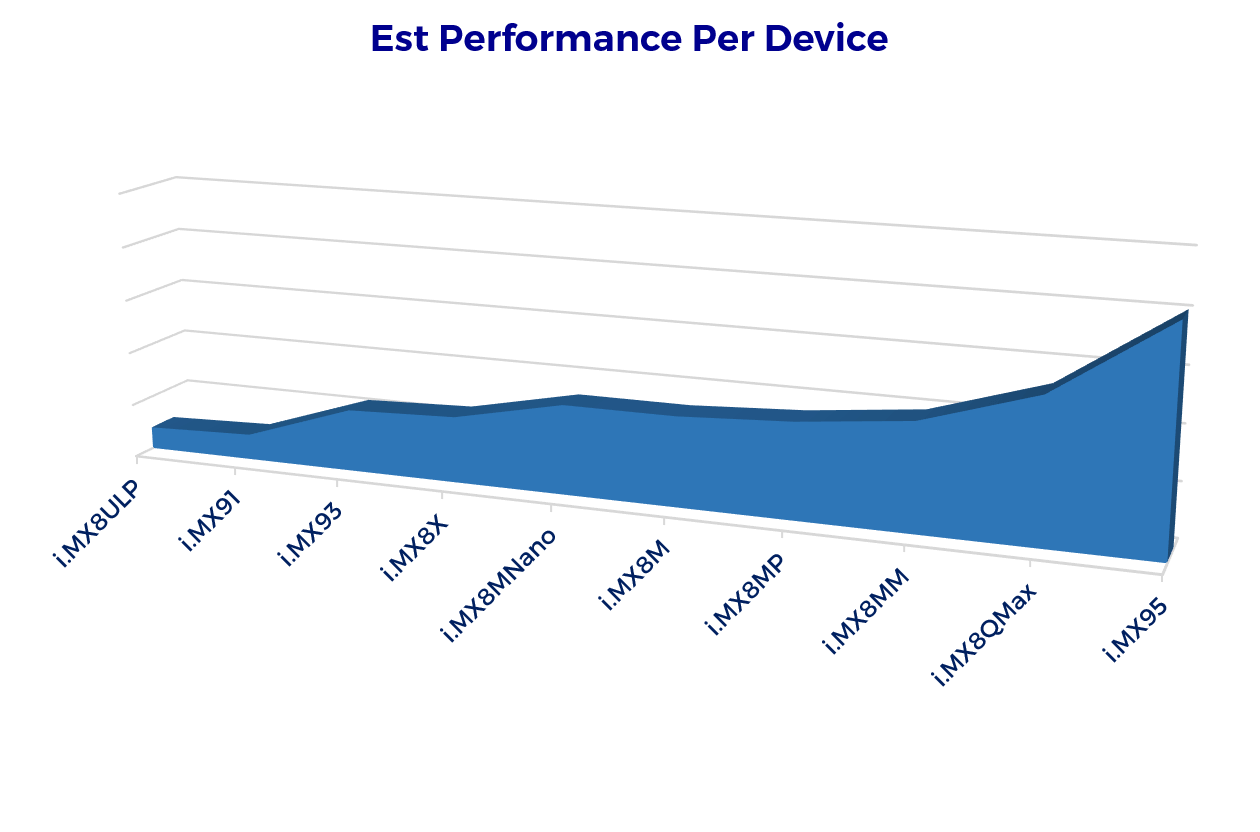
Section 2: Features Overview
Beyond the compute performance metrics, these embedded CPUs have a very wide range of the features offered and these play a critical role in their appeal to different applications. Some notable features across the range include:
- Graphics Capabilities: All devices have some form of display output support and most have integrated 2D/3D GPUs ranging from simple to advanced graphics rendering, making them ideal for applications requiring high-quality visuals.
- Video Capabilities: Depending on the device, video encode/decode engines are included, although care must be taken as performance and codec different between models. Some support H264, others H265, and there are also some 1080-capable or 4K-capable. Decoding ability is not symmetrical with encode either, so be sure to carefully check your required feature set and what each chip can cope with. Video encoding support up to 4K30 is possible, though, with simultaneous 4K60 decode on some variants.
- Connectivity Options: NXP processors come with a range of connectivity options, including Ethernet, USB, PCIe, and various wireless standards like Wi-Fi and Bluetooth expected using companion chips to the overall solution. This ensures seamless integration into diverse systems. Almost all of these connectivity options will have hardware support – offloading much of the real-time effort – freeing up the CPU for compute tasks.
- Security Features: Security is paramount in today’s digital landscape, and the i.MX8/i.MX9 CPUs offer security features such as secure boot, encryption engines, trusted compute zones, in-built TPM and key storage for safeguarding sensitive data.
- Environmental Features: NXP heritage is not just in industrial control but also commercial and automotive spaces. Unsurprisingly, each CPU variant has a number of sub-variants allowing fine tuning of compute cores and feature selection for cost reasons. Along with this, there is a choice of commercial, industrial and automotive temperature ranges. These temperature ranges also give differing guarantees on lifetime. For instance, commercial spec devices are not typically rated for 24/7 use for their normal lifetime; industrial and automotive are rated at a higher temperature and for longer prolonged periods of use.
Section 3: Machine Learning and Digital Signal processing
Many industrial automation, medical and access control products do not use AI for their applications. They rely instead on tried and tested algorithms for to perform tasks.
To accommodate a range of applications, NXP has included some devices with NPU units, and/or others with DSP cores for these tasks if required.
These aspects don’t have to be used and many sub-variants of the particular devices will have the NPU/DSP removed to save cost if you aren’t using this in your product.
NPU enabled:

For DSP variants, commonly used for audio signal processing, we can see the very low power devices and upper i.MX8 have these available:

Section 4: Power Consumption Analysis
Power efficiency is a key consideration in many embedded applications where energy consumption directly impacts battery life.
NXP’s ULP (Ultra Low Power) processors have many features, such as multiple power domains and ultra-low modes, voltage and frequency scaling, and the ability to run its Arm Cortex-M33 microcontroller without the Arm Cortex-A35 cores powered.
This allows the designers to run a basic level of logic for sensor data collection; when an event occurs, wakes the main processor up quickly, using the full Linux operating system to perform a complex task such as screen output.
Even mains-powered devices typically have power consumption regulations, or just the additional heat complicates the design, requiring the inclusion of active cooling.
Most of the NXP CPUs can run without heat spreaders. Even the high-performance media encoder/decoder ones do not need active cooling; normally a passive cooler will suffice.
Section 5: i.MX9x vs i.MX8 core differences
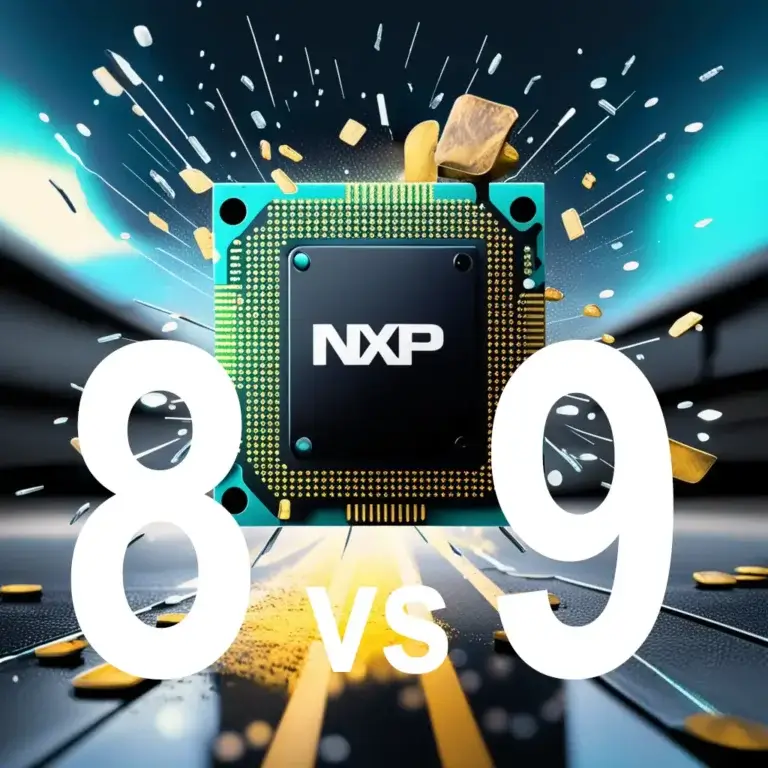
The i.MX91/93 are both very much geared to applications with a large number of serial interfaces without extensive media support as no GPU or video encode/decode blocks are available on either device.
The iMX95, which is pre-production (due out next year), is a powerhouse in comparison to the two others with a G310 V2 shader running at 4000 MPix/s.
That’s by far much more powerful than any of the i.MX8 devices (ranging from 296 to 3200 MPix/s), and it still retains its automotive roots. This can be seen with CAN bus support across all three devices and options of automotive temp ranges on all three devices.
All the iMX9x series have support of dual ethernet, and a huge amount of serial IO with 8 SPI, I2C and UART interfaces. Compare this with 3 or 4 devices in the iMX8 range.
The only one that outshines this is the i.MX8QMax with a crazy 18xI2C ports.
i.MX8 series of CPUs are in comparison geared to having one or more screens attached, graphical support, video encoding/decoding (although be careful as the features do jump around for this).
CAN bus support is only available on a handful in the range at the upper end of the scale, almost the opposite of the iMX91/93.
Section 6: Availability and Conclusion
The availability of these processors is an important consideration for developers and manufacturers looking to incorporate them into their designs.
NXP has a strong track record of providing reliable supply chains and long-term support for its CPUs, ensuring continuity of production and support for customers.
All NXP processors have 10-15 years of longevity from the release date, and the current EOL on any of their parts is readily available on the NXP website.
In summary, the NXP i.MX9x/8 series offers a compelling array of processors for embedded applications catering to diverse feature sets.
We’ve put together a table that brings together all the main headline features of the ranges to aid you in your processor selection:
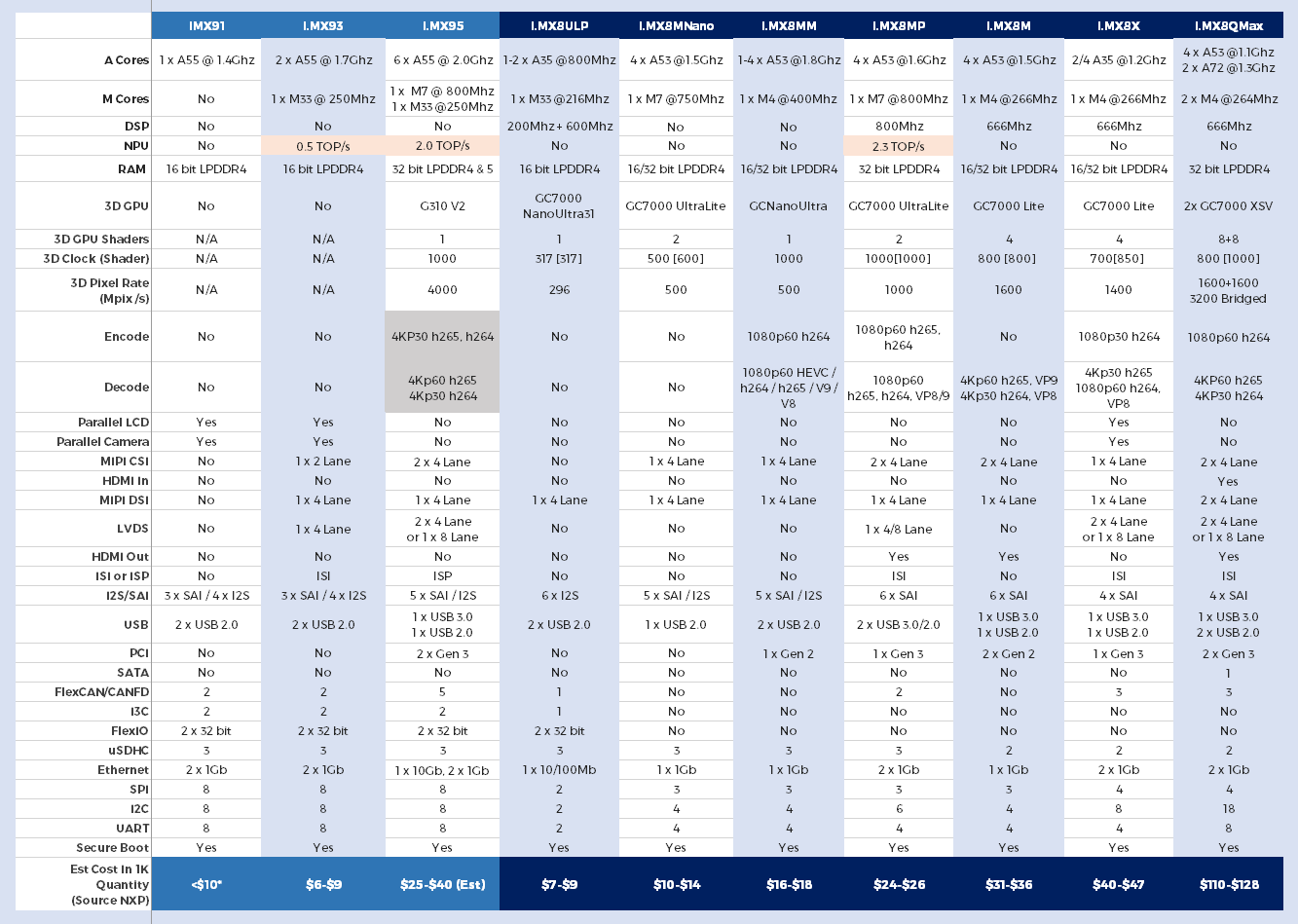
By carefully assessing the specific needs of your applications and selecting the most suitable model, developers can leverage the capabilities of these powerful processors to drive innovation and efficiency in their projects.

ByteSnap Design co-founder Graeme Wintle is one of the UK’s most experienced Microsoft Windows CE developers and is highly sought after for his expertise in migrating and security operating systems.
After graduating in Software Engineering from Newcastle University, Graeme quickly distinguished himself in software development at Nokia, GST Technology and Intrinsyc.
Graeme has been helping companies around the world with embedded software development for over twenty years. His cutting-edge design work has been instrumental in establishing ByteSnap at the forefront of embedded system design.
Graeme is the inventor of powerful, flexible user interface development framework, SnapUI.
Knowledge Panel - i.MX FAQs
What are the key features of the i.MX8 processor?
The i.MX8 processor boasts features like multicore processing, advanced graphics capabilities, high-definition video processing, secure boot options, and power efficiency in a smaller process than the previous i.MX6 CPUs. These features make it suitable for various applications ranging from automotive to industrial automation and IoT devices.
How does the performance of the i.MX8 compare to its predecessors?
The i.MX8 offers significant performance improvements over its predecessors, less power consumption per Mhz on top of higher core numbers and more features. Upgraded features like improved graphics capabilities and expanded connectivity options, the i.MX8 sets a new standard in performance within the imx series.
What are the different versions of i.MX8 available in the market?
There are 7 versions of the i.MX8 processor available in the market, including i.MX8MNano, i.MX8Mmini, i.MX8MPlus. Each variant offers different features and performance capabilities to cater to various application requirements.
Can you explain the architecture of i.MX8 in simple terms?
The i.MX8 architecture is a powerful system-on-chip (SoC) designed by NXP Semiconductors. It integrates multiple processing units like CPUs, GPUs, MPUs and DSPs on a single chip. This allows for efficient multitasking and performance in applications ranging from automotive to industrial automation.
What are the advantages of using i.MX8 for embedded systems?
The i.MX8 offers advanced processing power, high-performance graphics, and efficient power consumption, as an embedded focused chip support documentation is available for all aspects of the chip along with extensive software support for the many areas it can be used in, with longevity also it makes a stronger choice for bespoke devices over other ARM chips.
What are the key features of the i.MX9 processor family?
The i.MX9 processor family offers performance and power efficiency focused on automotive and industrial focused devices. Solid security measures, demands of next-generation embedded applications in automotive, industrial, and IoT sectors.
How does the i.MX9 family improve upon the i.MX8 series?
The i.MX9 family complements the i.MX8 series with a focus on more automotive features such as CAN bus, FlexIO where the i.IMX8 family has a more media orientated devices with more choices of GPU, video encoding and decoding support on top of the extensive connectivity and interface options.
What are the main differences between the i.MX8 and i.MX9 processor families?
The main differences between the i.MX8 and i.MX9 processor families include:
- In general more automotive focus with the i.MX9 and higher levels of serial protocols (I2C/SPI/UART/FlexIO/Can), where the i.MX8 has more media focus, more choices of GPU and video encoding and decoding support.
- Security: Both families offer extensive security options
- Power Efficiency: Both families of devices are power efficient, depending on the hardware features the CPUs have the capability to consume more power, the ULP devices are very low power and aimed at wearable devices.
- Graphics Capabilities: The i.MX95 has the highest level of graphics processing but otherwise the i.MX8 series is the standard go to device range for advanced display technologies and high resolutions.
- Connectivity: The i.MX9 family supports newer, high-speed interfaces and connectivity options, catering to the evolving needs of IoT applications.
What applications are best suited for the i.MX9 processor family?
The i.MX9 processor family is well-suited for a wide range of applications, including:
- Automotive systems or where CAN bus support is needed.
- Industrial automation and robotics, loads of interface options like I2C, SPI, Seral, PCI, Ethernet etc
- AI-powered IoT devices and edge computing applications using the iMX93/95
- High-performance human-machine interfaces (HMIs) on the iMX95
- Smart home and building automation systems
- Headless low power devices using the i.MX91/93
How does the i.MX9 family address the growing demand for AI in embedded systems?
The i.MX9 family addresses the growing demand for AI in embedded systems by incorporating dedicated neural processing units (NPUs) and optimised AI acceleration. This allows for more efficient execution of AI and machine learning algorithms directly on the device, enabling edge AI applications and reducing the need for cloud-based processing. As a result, developers can create more responsive and privacy-conscious AI-powered embedded systems using the i.MX93/95 processors.
What development tools and support are available for the i.MX9 processor family?
NXP provides a comprehensive ecosystem of development tools and support for the i.MX9 processor family. This includes:
- Linux BSP including prebuilt images for use on the NXP EVK reference boards.
- Evaluation boards and reference designs to accelerate prototyping
- Extensive documentation and application notes
- Community forums and technical support from NXP experts
- Third-party tools and middleware support from NXP’s partner ecosystem
These resources help developers quickly bring their i.MX9-based designs to market, reducing development time and costs.

